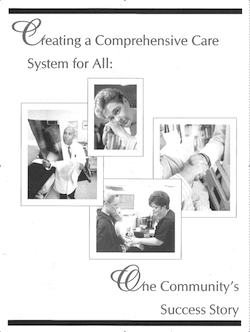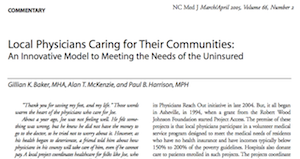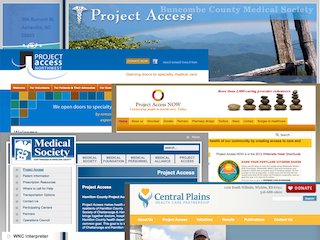by Shyla Nambiar; Published 12/27/2012 (revised 12/4/20); © 2012 Shyla Nambiar
Medical emergencies can happen to anyone, regardless of income level, but for a person who cannot afford them, the impact is much more severe. For instance, one woman who had heart surgery for a tumor, said, “My medical bills, including after care, were in the neighborhood of $200,000.”
Luckily for her, help arrived in the form of an innovative organization called Project Access.
“Project Access covered all of the expenses, including a week in ICU, doctors’ bills, hospital and medication charges, and outpatient care at Heart Path. If I had not had a Project Access card in my purse, I would not have gone to the ER because of my fear of not being able to pay for treatment, and I would be dead today. The doctors estimated that I would have died of a massive heart attack or been killed or incapacitated by a massive stroke within a week.”
Uninsured Patients

Healthcare reform in the United States has led to contentious debates and a 2012 Supreme Court ruling. While the issue remains controversial, millions of working Americans currently live without health insurance. The traditional stopgap has been the physician, the cornerstone of patient health, so much so that many doctors willingly give free healthcare to those who cannot afford their fees. According to the W.W. Kellogg Foundation, “Most of the health care received by the poor and uninsured is provided in doctors’ offices.”
About 70% of physicians in the US provide care to uninsured patients. While free or low-cost healthcare services are provided by individual doctors acting on their own, Project Access, a physician-driven program, was established to facilitate the delivery of these services to uninsured patients.
Project Access started in Buncombe County, North Carolina, where its headquarters are located in Asheville, in the heart of the Great Smoky Mountains. Founded in 1996 as the first of its kind, the award-winning Project Access is an initiative by the Buncombe County Medical Society [now, Western Carolina Medical Society] to coordinate access to local healthcare for uninsured people who are not eligible for public assistance.
While doctors in the Asheville area had previously been providing care on their own, Project Access was an effort to systematize and manage the process of obtaining and delivering healthcare, thereby streamlining access for patients and doctors. Project Access organizations and similar groups have since sprung up across the country to coordinate medical services to the uninsured.
Aiding Generous Physicians
Project Access in Buncombe County was founded by Drs. Suzanne Landis, Phil Davis, James Powell, and Paul Martin. At that time, the county was home to an estimated 15,000 uninsured low-income people. Dr. Landis stated that previous to establishing Project Access, “Doctors’ efforts were not well-coordinated.” With the aid of a grant from the Robert Wood Johnson Foundation to create a physician-led system, Project Access began enrolling patients in June 1996.

Among the many patients she has seen, Dr. Landis in particular remembers a janitor with asthma who she treated for free. “He was on a rocky course with his asthma,” she said. She enrolled him in Project Access and he was able to obtain lower-cost medication and an inhaler. His health subsequently improved.
Project Access is allied with the Buncombe County government and various county healthcare institutions, such as the health department, local hospitals, pharmacies, and clinics. County funds help pay for medications at pharmacies.
Project Access has been such a success that 13,000 out of 15,000 qualified county residents receive healthcare access now. Emergency room and clinic visits by Project Access patients has been reduced. Uninsured residents who enroll with Project Access are less likely to go to the ER and more likely to report being in good health than insured residents.
Nuts and Bolts of the Program
Buncombe County physicians who volunteer pledge to see a certain quota of patients annually: 10 patients for primary care physicians and 20 patients for specialists. About 85% of county doctors have enlisted in the program. The enthusiasm for Project Access is so marked that, according to Miriam Schwartz, CEO and executive director, “In some practices, volunteering for PA is expected of new physicians who join the practice.” Doctors provide medical services valued at $4 million a year, and the success of the Buncombe County has sparked other North Carolina counties to introduce their own programs.
Project Access functions as a referral service, matching up patients with the appropriate healthcare provider. Patients must meet the eligibility criteria, which includes an income below 200% of federal poverty standards and county residence for at least six months. This organization is meant to serve as a safety net for low-income, uninsured people who do not qualify for programs such as Medicaid but who cannot afford health insurance and do not have insurance through their employers. It is meant to provide short-term assistance to low-income patients, not as an alternative to health insurance.
When a patient is accepted into the program, Project Access makes an effort to find an appropriate physician for the patient’s condition, either a primary care physician or specialist, from its volunteer pool. A primary care doctor who sees the patient is then responsible for evaluating the patient or referring the patient to a specialist.
Positive Patient Responses
Patient feedback attests to the benefits provided by this program to individual patients as well as the community as a whole. A letter to the local Mountain Express newspaper, written by a former patient, expressed the feelings of many of those who have been helped. A native of the county who was disabled by a shoulder injury, Troy Amastar exemplifies the dilemma of those who do not have health insurance though their work. He wrote, “I can’t tell you how grateful I am to Project Access that I was able to get an MRI done and am now getting physical therapy for my shoulder, without the added worry of how I will pay for it.”
Another recipient of Project Access’ help wrote, “Because I am one of the many working people living below the poverty level I was not eligible for any federal assistance (ie, Medicaid) at all. And again, because I was (and am still) living below the poverty level, I did not have the funds to properly attend to my health.” She was diagnosed with endometrial cancer. “I knew nothing about Project Access at that time and I thought that my diagnosis was a death sentence. . . . I am alive because of Project Access, and the grace of God. I have had several major health issues, a couple which could have been deadly, since enrolling in Project Access. Thanks to the generosity of those involved with this program, my medical needs have all been met.”
Regional Growth
As of late 2012, 92 organizations in the US have adopted the Project Access model for their own communities. While these organizations are stand-alone efforts, they aid each other through an informal network.

The members of Buncombe County’s program were instrumental in encouraging the formation of a Project Access in nearby Chattanooga, Tennessee. Dr. Joe Cofer became familiar with the activities of Buncombe County’s organization and helped to found a similar system in Hamilton County. Directed by Rae Bond, this group began operation in 2004. Similar to the original program, the Chattanooga group is also a partnership of local healthcare entities such as hospitals, clinics, health centers, and the Hamilton County health department.
The needs of the program change from year to year but, since its inception, Hamilton County Project Access has provided $65.5 million in healthcare services. As it received support and training from the Buncombe County group, it has reciprocated by providing encouragement and aid to other communities seeking help in creating their own Project Access organizations.
While programs such as Project Access should not be considered an alternative to health insurance or healthcare reform, for many sick people who must work but still cannot afford health insurance, Project Access offers assistance and helps to change lives. For doctors, it confirms why many of them chose the profession. According to Dr. Landis, “Project Access really brings back why we went into medicine. It’s extremely satisfying to be involved in this.”
Related Links
- Project Access – Western Carolina Medical Society
- Project Access Receives Grant from Dogwood Health Trust
- Project Access – Hamilton County
About the Author
Shyla Nambiar is a freelance writer based in Atlanta, Georgia.
